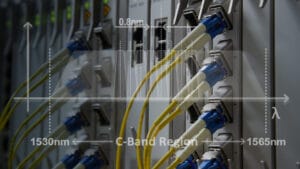
When faced with fiber constraints, single fiber CWDM or DWDM solutions can be an ideal cost-effective method of adding new services. In this article, we will discuss the conditions under which each method is the best fit.
Summary of Options

Method 1: Single Fiber Single Wavelength (SFSW)
Single fiber single wavelength (SFSW) usespecialized opticsto transmit and receive data along the same CWDM wavelength, providing for the addition of up to 8 additional services. However, these transceivers offer only simplex transmission and require APC connectors at the transceiver end.

Use this if…:Because of the limitations listed above, we do not recommend this solution for most applications.
Method 2: Hi-Lo Bi-Di’s
These specialized optics improve upon method 1 by offering full-duplex transmission and up to 8 additional services. These optics operate as a traditional bi-di pair, transmitting and receiving on wavelengths just above (“high”) and below (“low”) the central CWDM wavelengths.

Use this if…:You need to add many services over a shorter distance.
Method 3: 2-Channel Services
This method uses adjacent channel wavelengths to transmit and receive. The advantage to this solution is it can be used for either CWDM or DWDM network designs. It does not require specialized transceivers; standard dual fiber CWDM or DWDM transceivers will work. This solution can be used to add up to 4 (CWDM) or 20 (DWDM) services and can span distances of up to 120km (i.e., the rated distance of the optical transceiver).

Use this if…:You need to maximize the distance between services and prefer to use standard dual fiber transceivers.
Method 4: The Mux/Demux Solution
This solution uses a mux/demux filter to double the number of possible new services from Method 3 (up to 40 using DWDM, and 8 using CWDM). While this solution also enables you to use standard (dual fiber) transceivers, the higher loss shortens the distance between locations that this solution can travel.

Use this if…:You need to maximize the amount of new services over a shorter distance and need to use standard optics.
Need more help determining which solution is right for you?Contact us todayfor a full consultation.

